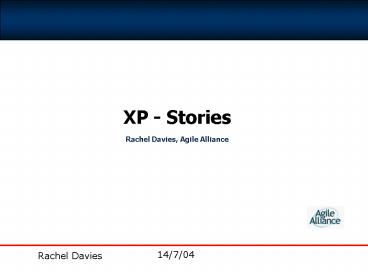XP Stories - PowerPoint PPT Presentation
1 / 21
Title:
XP Stories
Description:
Stories should be testable.' 'Stories need to be of a size that you can ... 'Stories don't have to represent business value to the customer team, but they do ... – PowerPoint PPT presentation
Number of Views:91
Avg rating:3.0/5.0
Title: XP Stories
1
XP - Stories Rachel Davies, Agile Alliance
2
Analysis
- Analysis helps us to identify the full set of
behaviours required of a system - When we analyse prior to engagement of IT we risk
expanding requirements without understanding the
cost of our decisions - If we want ROI then we need to identify both
business value and cost of implementation for our
requirements before construction
3
Minimum Marketable Features?
- Standish Report 2002
4
Embrace Change
- We model to Understand and Communicate but models
are not enough - We cannot expect to do complete analysis without
feedback - We cannot expect documents to speak for
themselves without ambiguity - Keeping documents updated to reflect changes is
time-consuming - Face-to-face communication is richer
5
On-site Customer
- XP uses the Customer as the source of knowledge
for all system requirements - An On-site Customer is used instead of
documentation - Story cards represent requirements in the plan
rather than documenting them - Customer vision evolves based on feedback from
iterative deliveries
6
Agile Manifesto
- Individuals and interactions over processes and
tools - Working software over comprehensive documentation
- Customer collaboration over contract negotiation
- Responding to change over following a plan
- While there is value in the items on the right,
we value the items on the left more
7
The role
- The On-site Customer needs to
- Gain approval from other stakeholders
- Communicate context, required outcomes and
acceptance criteria - Prioritise work based on business value
- Be available to answer questions during
development - Accept or reject delivered solutions
8
Stories - Time-boxed by definition
- One thing the customer wants the system to do.
Stories should be estimable at between one to
five ideal programming weeks. Stories should be
testable. - Stories need to be of a size that you can build
a few of them in an iteration - Stories don't have to represent business value
to the customer team, but they do have to
represent progress. Only the customer team knows
what it will consider progress, so they have to
do the slicing Kent Beck
9
More that words
- Ron Jeffries
- Card story text
- Conversation discuss the details
- Confirmation record acceptance tests
10
Story Format
- Sticking to a story format can help
- Title (not a reference number)
- Concise problem statement
- As I want so that value
- Any other relevant notes, sketches of screen
layout, etc.
11
Slicing the cake
- There are many ways of slicing a large story
- Do this with developers, they understand what
parts can be implemented separately - Thin slice thru all layers
- Fake out backend
- Screen by screen
- Field by field
- You may need some way of linking all the stories
to your high level requirement
12
Acceptance Tests
- To prevent developers expanding scope acceptance
tests need to be clearly stated - Simple format
- When I do this action, I expect this result
- The project should aim to build acceptance tests
into a suite that can be automated - More detailed tests may need to be defined during
iteration - You can work with specialised QA to improve your
tests
13
Story Attributes
- The acronym "INVEST" can remind you that good
stories are - I - Independent
- N - Negotiable
- V - Valuable
- E - Estimable
- S - Small
- T Testable
- from XP Explored by Bill Wake
14
Why index cards?
- You cannot fit much text onto an index card!
- Tactile qualities get everyone involved
- Influence..
15
Release Planning
- If the system/business domain are well understood
then a Release Plan may be built - High-level stories are written
- Rough estimates are applied
- Stories are prioritized
- By business value
- By risk
- The resulting release plan is updated based on
delivered iteration change is expected
16
Iteration Planning
- Before the Iteration Planning Game
- Select candidate stories
- Developers cannot estimate stories without
acceptance tests - Understand that the team use measured Velocity
(Yesterdays Weather) predict future delivery - There may be stories that were not finished last
iteration to be re-estimated
17
Pitfalls
- System requirements may be too large to be held
in memory by the Customer - Customer does not have enough time
- Customer is not in the same building
- Customer blind-spots missing tests
- Losing parts of big stories
- Customer team, many voices
- Customer sitting with Developers may
- lose touch with business
18
Scaling up
- Scaling up is possible but may cause slow down as
other problems are introduced - Multiple customer teams where customers own
different functional areas - Risk increased communication overhead
- Gaps in ownership
- Story repositories and documents
- Risk duplication
19
Questions?
- Any questions?
20
Exercise
- Split into triples
- Choose roles Customer, Developer, QA
- Take example a stack of index cards
- Split the example into multiple Stories
- Write an index card with a story on the front
- Acceptance tests on the back
- Teams swap stories for judging
- Using INVEST attributes for scoring
- Prize for the team with the most Stories!
21
References
- Extreme Programming Explained Beck
- Extreme Programming Explored - Wake
- Writing Effective Use Cases Cockburn
- User Stories Applied Cohn
- Requirements By Collaboration Gottesdiener
- Use Case Zone pages http//www.pols.co.uk/use-case
-zone/index.html - C2 wiki pages
- www.xp123.com































